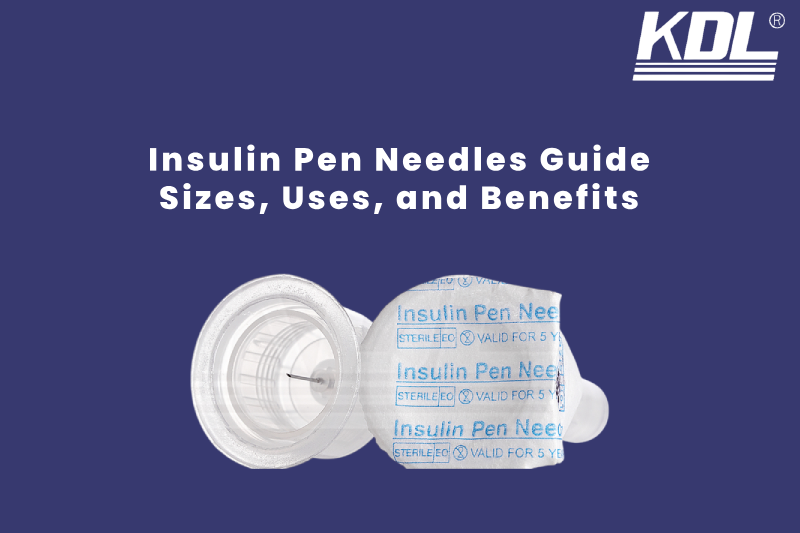
When you have diabetes, you need to pay close attention to your insulin levels and how you give yourself insulin. Insulin pens make it easy and handy for many people to inject insulin without having to take doses from a bottle. The insulin pen needle , on the other hand, gets forgotten about.
You can get more accurate and comfortable insulin pen needles if you choose the right size and type. In this article, we’ll tell you all you need to know about insulin pen needles, such as their sizes, uses, and advantages. This will assist you make smart, confident decisions about how to care for your diabetes.
What Are Insulin Pen Needles?
Insulin pen needles are small needles that are used only once and are attached to the end of an insulin pen. They let insulin move from the pen to the fat under your skin, where it can be taken in by your system.
Attach a new needle to your pen each time you need to shoot insulin. Give yourself the dose, and then safely take the needle off and throw it away.
Insulin pen needles are not all the same. They come in different sizes, lengths, and gauges, which all affect how easy and effective the injection is.
How Insulin Pen Needles Work
When you press the pen’s button, the insulin goes into your skin through the tube that’s connected. It’s not meant to go into the muscle, but into the subcutaneous tissue, which is the fat layer under your skin.
Insulin can get into the muscle if the needle is too long or placed too deeply. This can hurt or slow down the insulin’s work. Picking the right needle length is important because it helps your insulin work right.
Insulin Pen Needle Sizes Explained
Insulin pen needles vary by two main measurements: length and gauge. Let’s look at both.
Needle Lengths
Modern insulin pen needles are much shorter than they used to be. In the past, longer needles were common, but today, studies show that shorter needles work just as well for most people and they’re more comfortable too.
| Needle Length | Typical Use | Notes |
|---|---|---|
| 4 mm | Most users, including children and adults | Shortest and most comfortable; effective for all body types |
| 5 mm | Common choice for adults | Slightly longer but still comfortable |
| 6 mm | Used by people who prefer a bit more depth | May need to pinch skin before injecting |
| 8 mm | Older standard; sometimes used by those with thicker skin | Pinching the skin is often recommended |
Key takeaway:
A 4 mm or 5 mm insulin pen needle is usually ideal for most people with diabetes. These shorter needles reduce the risk of injecting into muscle while providing the same insulin delivery results.
Needle Gauge (Thickness)
The gauge of an insulin pen needle refers to how thick it is. A higher gauge number means a thinner needle.
Common insulin pen needle gauges include 29G, 31G, and 32G.
| Gauge | Thickness | Comfort Level |
|---|---|---|
| 29G | Thicker | Slightly more pressure, less comfortable |
| 31G | Thinner | Common and well-balanced |
| 32G | Very thin | Ultra-fine, designed for the least discomfort |
Thinner needles (like 32G) are designed to make injections gentler and nearly painless. That’s one reason ultra-fine insulin pen needles have become the most popular choice.
How to Choose the Best Insulin Pen Needle Size for You
There isn’t just one “best” size of needle for an insulin pen. Your body type, level of comfort, and the way you get injected will determine which one is best for you. But here are some broad pointers:
- Most adults and kids can use 4 mm or 5 mm needles without any problems.
- If you use older pens or have thicker skin: You might use 8 mm, but always ask your healthcare provider before switching.
- If you bruise easily or fear injections: Ultra-thin 32G needles can make a big difference in comfort.
Always talk with your doctor, diabetes nurse, or pharmacist before changing needle size. They can help you find the right match for your insulin type, body type, and lifestyle.
How to Use an Insulin Pen Needle
You can avoid leaks, feel less pain, and be sure you get the right dose if you know how to properly connect and use your insulin pen tip.
Step-by-Step Instructions
- Wash your hands: To keep from getting sick, always start with clean hands.
- Attach a new needle: Take the insulin pen’s cap off and then twist or push a new needle onto the pen tip until it’s in place.
- Remove the caps: Take off the outside cap and put it somewhere else. After that, take off the inner cap and throw it away.
- Prime your pen: Press the needle button and dial up 2 units to let insulin out into the air. This makes sure the pen works and gets rid of any air bubbles.
- Type in your dose: Set your insulin dose to the right amount as directed.
- Inject the insulin:
- Pick where to give the shot (abdomen, thigh, or upper arm).
- If you’re using a longer needle (6 or 8 mm), pinch up a fold of skin very lightly.
- Press the injection button and put the needle in straight.
- To ensure the needle delivers the full dose, hold it in place for 10 seconds before removing it.
- Take the needle off and throw it away : The top cap makes it safe to unscrew the needle, and then you can put it in a sharps container.
Benefits of Using Insulin Pen Needles
Insulin pen needles offer many advantages compared to traditional syringes and vials. Here are some key benefits:
1. Easier to use
Manufacturers design insulin pens and needles for easy use. You don’t have to measure or draw insulin by hand; you just attach a needle, set the amount, and deliver. This is very helpful for kids, older people, and people who have trouble seeing or using their hands.
2. More accurate dosing
With an insulin pen, you can give the right amount of insulin, even in half-unit or single-unit amounts. With a small needle, you can give insulin exactly as directed, without having to guess.
3. Greater Comfort
The needles in insulin pens today are shorter, smaller, and sharper than ever before. They go smoothly into the skin, which makes needles less painful and less scary. With very thin needles, many people say they barely feel the shot at all.
4. Safe and easy to carry
It’s easy to take insulin pens around because they are small. You can quickly and quietly inject insulin anywhere at work, on the road, or at a restaurant. You don’t need to bring a full kit of supplies.
5. Less likely to get hurt by a needle
Pen tips only need to be use once and connect straight to the pen, so there is less handle. As a result, users experience a lower chance of getting a needle stuck while using or disposing of it.
6. Better follow-through and consistency
People are more likely to take their insulin as recommended when they can do it easily and without pain. That makes it easier to control blood sugar and take care of diabetes in general.
When to Change Your Insulin Pen Needle
To keep yourself safe and to get the most out of your insulin pen, you should use a new needle for each shot, even if it seems like a waste.
When pen needles are reuse, they can:
- Injections that are dull and hurt
- Needle clogging
- Insulin amounts that were not right
- The chance of infection
- Anger or bruises on the skin
Comfort and correct insulin release are always guaranteed by a new, clean needle.
Insulin Pen Needle Safety Tips
To keep your injections safe and effective:
- Use each needle only once: Never reuse or share needles, even with close family members.
- Store your insulin pen properly: Keep insulin at the recommended temperature to avoid damage.
- Dispose of needles safely: Use a FDA-cleared sharps container or a heavy-duty plastic bottle with a screw-on lid.
- Check your technique: Ask your diabetes care team to watch your injection technique occasionally small corrections can improve accuracy.
The Bottom Line: Finding the Best Insulin Pen Needle for You
Diabetes control depends on insulin pen needles, which look small but are very important. Every injection is more relaxing, accurate, and successful when the needle length and size are just right.
The best needle for most people to start with is a small, thin one (4 mm, 32G). The insulin works well for all body types and doesn’t hurt much.
Remember this always:
- Every dose should have a new needle.
- You should switch up where you put.
- Properly throw away needles
- Prior to changing needle sizes, talk to your doctor or nurse.
Take charge of your diabetes care one easy shot at a time by learning about insulin pen tip sizes, how to use them, and the benefits they offer.
 +86-791-8686-1216
+86-791-8686-1216 

